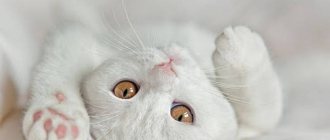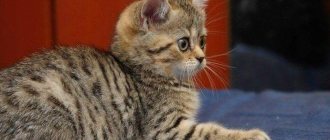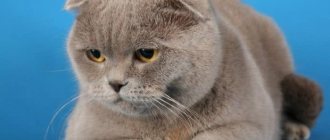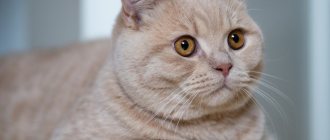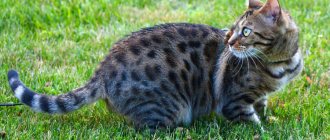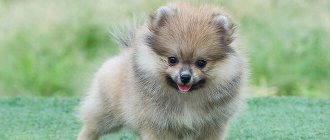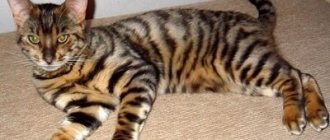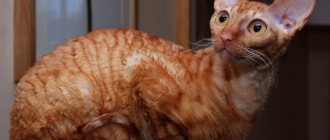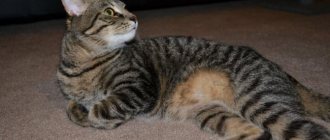Origin story
Tracing the ancestors of British cats is difficult.
One can only assume that they were brought to the British Isles by the Roman conquerors. And they were different in appearance: they were more graceful and long-legged, without the charming plumpness of their cheeks. Having multiplied, the cats began to get closer and closer to human habitation and gradually became tamed. For a long time they were treated with disdain, but in the 19th century everything changed. It has become prestigious to keep British cats as pets in homes. This is what many aristocrats of the Victorian era did.
In 1871, the first exhibition took place in London, the first standard, competition regulations and scoring system were developed. And all this is thanks to enthusiasts Crystal Palace and Harrison Ware.
At the end of the 19th century, British cats were pushed out of the top popularity by Persian cats, and later the Second World War broke out. To save the breed, the British were actively bred with Persians, Chartreuses, and Russian Blues. It was because of this forced random crossing that the breed was long refused to be recognized by both world and regional felinological organizations.
It wasn't until 1980 that the Briton cat breed was recognized by The Cat Fanciers' Association (CFA).
For a long time, long-haired kittens were discarded: only British shorthairs were popular. But since 2001, the breed was recognized as experimental, its own standard was developed for them, and owners were allowed to participate in exhibitions and receive titles and awards.
The cost of an individual consists of several factors: compliance with generally accepted breed standards, title status of the parents, popularity of the nursery, and the amount spent on grooming. Classic cats - cats with blue fur and copper-yellow eyes - are somewhat cheaper than those with bright green eyes and golden chinchilla color. You can buy a kitten from a private breeder for 5-10 thousand rubles, but these are pet class kittens. Babies for exhibitions and competitions (show class) cost much more: 30-5 thousand rubles.
History of British Longhair cats
The past of the Lowlanders cannot be called ancient, much less glorious.
The breed arose due to a recessive gene for long hair, the carriers of which, according to felinologists, should not have been allowed to reproduce. Moreover, the breeders themselves were to blame for the genetic failure; in the mid-50s they wanted to expand the color palette of British shorthairs by crossing them with Persians. At first, everything went according to plan: kittens born from mixed “marriages” inherited the luxurious colors of Persian cats and the short hair of their English parents. However, after several generations, the “increased fluffiness gene” made itself felt, and the animals began to bear long-haired offspring. Breeders were not prepared for such a surprise, so at first they strictly rejected fluffy kittens, selling them for a symbolic price, or even for free, provided that no one would breed such pets.
Soon, the longhaired variation of the British found a few fans who began to “push” the breed into the TICA and WCF breeding lists. But since the British cats were distinguished from their English ancestors only by their voluminous fur coats and nothing more, some felinological clubs in Europe and the USA continued to register them as a variety of British cats. At the same time, TICA recognizes Lowlanders, although for now in the status of a new breed.
Important: today, crossing Persians with British shorthair and longhair cats is prohibited. At the same time, matings between Lowlanders and traditional British are allowed by some clubs.
Standards
British Longhairs are quite large animals. Cats weigh on average 4.5-6 kg, males - up to 9 kg.
| Standard | Description |
| Head | The skull is round, the cheeks are full, the forehead is rounded, the cheekbones are wide. The “stop” is barely noticeable, the nose is straight and wide. The ears are wide at the base, small in size, and their tips are rounded. Set a bit low. The chin and nose form a vertical line. |
| Eyes | Round, large, open, widely spaced. The color of the iris always harmonizes with the color of the coat; it can be green, blue and yellow in all shades. Heterochromia is allowed in snow-white individuals. |
| Neck | Very short, muscular. Adult cats visually have no neck at all. |
| Torso | Powerful, muscular, no looseness. The chest is deep and wide, the back is massive, and so is the hindquarters. Wen is allowed in the abdominal area. |
| Limbs | Powerful, short. Paws are plump, with elastic round toe pads. Between the toes the fur grows in thick tufts. |
| Tail | Wide, medium length, wide at the base, tapering towards the tip. He is very pubescent. |
| Wool | The coat is elastic, thick and shiny. The fur is very long and sticks out in different directions. There is a slight spring under the palm, it feels like plush, but rougher than that of the British Shorthair. The undercoat is dense and of medium length. Puffy “pants” at the back and a “collar” on the neck are welcome. |
Features of the British Longhair
The standards defined by the World Feline Federation state: It is allowed for the body to be medium/large in size and of a “sports character”. The cat must be massive. The paws are short, rounded, and the head is slightly flattened.
The eyes are large and set wide. The iris depends solely on the color of the British Longhair. Weight depends on gender: from 4 kg to 7 kg.
The coat, as has already been said, should be voluminous, shiny, with a thick undercoat; on the tail it should also be crumbly.
The presence of a “collar” and “pants” on the hind legs is mandatory. The color of a cat can be absolutely anything.
The length of the life cycle depends on lifestyle and care; in principle, a pet can easily live 10-15 years.
Note!
Singapore cat: character, photo, price, breed description, reviews, how to buy, how to choose, maintenance, care and owner reviews
Scottish Straight: cat photo, kitten prices, breed description, character, reviews, maintenance and care, nutrition + interesting facts
Chausie - overview of the breed, character and breeding characteristics. Price for a kitten and tips for choosing a purebred cat (115 photos)
Character and behavior
British longhair cats are luxurious and full of charm animals with royal habits and absolute harmony in their souls. Looking at these plump cheeks and plump paws, there is a desire to squeeze and knead this charming big-eyed creature, but beware! Kittens are more or less loyal to this due to their age, but adult cats are unlikely to tolerate such familiarity towards them. This is their distinctive feature: their reluctance to sit in the arms of even their owner. The cat may even raise its paw if you try to pull it, sleepy, from its bed, or distract it from dinner.
For a British cat, the main person in the house is himself. The rest are servants, to whom he can be more than lenient. And don’t expect much more: you are allowed to feed him, pet him and entertain him - what else?
Nevertheless, it is also impossible to say that the British are absolutely independent and such crackers. They, like other living beings, need affection and tenderness, but they just accept it all on their own terms. Moreover, with age, the need for affection increases noticeably and cats become more “accommodating”.
They are very curious: they often follow a person and enthusiastically watch his manipulations. Kittens and teenagers are very playful, like all children: they love to chase around the apartment, catch balls and ribbons with their paws, hunt flies and cockroaches, climb cabinets and tug at curtains. Be sure to buy your pet several suitable toys; a (small) play set will not be amiss.
At an advanced age, British Longhairs no longer prefer active, but passive pastime: lazy lying on the sofa, watching what is happening outside the window, sleeping for many hours.
In the absence of people, they will not spoil the atmosphere in the house. They are not loud, but they will not remain silent if their bowl is empty. During the rutting season they are active, they can scratch doors and mark their territory.
They treat children with caution and are patient with children’s whims and pranks, but to a certain limit. If a child repeatedly does something that the cat doesn’t like - pulls the tail, hits the ears, and so on - the Briton will snort and fight back, with a paw with claws. Keep this in mind when getting a kitten in a family with children.
When buying a kitten without documents from an unknown breeder, you risk running into an unscrupulous businessman who sells kittens with serious physical defects and bad character. Be careful!
Choosing a kitten and cost
The choice of a kitten should be based on finding a good breeder and positive reviews. Before purchasing, you should visit several places and look at the parents of the future animal.
The cost of a purebred longhaired British dog depends on many factors:
- parents' pedigree;
- nursery status;
- color;
- sex of the kitten.
The price is different and varies between 2000-20000 rubles. It can also vary depending on the class of cats:
- pet;
- breed;
- show.
Care instructions
British Longhairs are clean creatures, but they also need your little help.
Wool
Brush the fur 3-4 times a week with a special massage brush, use a furminator, and then remove fallen hairs with wet hands. You can bathe before childbirth, exhibition events, or if the animal is heavily soiled. Keep in mind: these individuals shed hair profusely all year round, and twice as much during the molting period.
Claws
To grind down claws, you need a scratching post: strong and stable, made from safe materials. But British Longhairs are often too lazy to use it, so once a month, pick up a nail clipper and carefully shorten the claws, trying not to damage the large vessels inside the fingers.
Do you trim your pet's nails?
Yes, he’s lazy with us. No, he sharpens himself.
Eyes
The British people's eyes often runny. The discharge is thin and dark in color - this is the norm. Wipe your pet's eyes with a cotton pad soaked in chlorhexidine or regular boiled water. You shouldn’t leave everything as it is: the discharge quickly hardens and, not only does it look untidy, but the cat, when washing itself, rips it off with its paw along with the fur near the eyes. Little by little, unsightly bald spots form on the cat’s face.
Ears
Use a damp cotton swab to remove wax from the ears once a month: without going deep and without pouring oil or any other liquid into the ears.
Teeth
Teeth should be brushed every week with a soft silicone or regular children's toothbrush (with bristles shortened with scissors).
Expert opinion
Dusheba Vera Ivanovna
In 2010, she graduated from the Moscow State Academy of Veterinary Medicine named after K.I. Scriabin with honors, specializing in veterinary medicine. I regularly attend veterinary conferences, congresses, and webinars.
Human toothpastes, washing gels, shampoos and other care products are not suitable for animals! Moreover, they are even dangerous, as they cause not only gastrointestinal disorders, allergic reactions, dermatitis, but also serious poisoning and even the growth of malignant tumors. Buy cat shampoos and toothpastes only in pet stores and carefully read the ingredients.
British cats love to sleep in closed houses, cozy and warm. It is better to choose wood or silica gel filler for the tray: they absorb urine and odors well. For food you need 2 bowls, preferably made of ceramic or metal (drinking fountains are very popular).
The photo shows a British longhair cat in moments of rest.
Purchasing a British Longhair kitten
Longhaired British cats are not uncommon, so purchasing a kitten now will not be difficult. There are a large number of nurseries and breeders who professionally breed these cats. You can buy a kitten through an advertisement from a private person.
Buying kittens of the longhaired British breed is not difficult.
Criterias of choice
When purchasing, you must first decide what kind of pet you need. Breeders divide kittens into classes:
- show - ideally meet all breed standards, are intended for exhibition activities and breeding, the price for such kittens is the highest and strongly depends on the characteristics of color, gender and specific characteristics of the pedigree;
- breed - have minor flaws in appearance, but are allowed to participate in exhibitions and are used in breeding, they are cheaper;
- pet - in appearance there are serious deviations from breed standards or even defects, which excludes their participation in breeding work, such animals are subject to mandatory castration or sterilization in order to avoid unwanted matings, their cost is low.
Only an experienced breeder and expert can identify a long-haired show-class British kitten.
You can buy a Highlander kitten without documents; such an animal will cost quite a bit. But no one can guarantee that this is a Briton at all, and not just a fluffy mongrel kitten. Only a specialist can accurately determine the class of a small pet, but severe deficiencies (bad bite, high-set ears, curled tail, etc.) can be seen immediately.
British breed kittens must have:
- the head is rounded on a short thick neck, the forehead is wide and round;
- plump, prominent cheeks;
- small round ears;
- the nose is medium without a visible transition in the forehead area;
- the eyes are widely spaced (the color is usually not yet determined);
- the limbs are short, the paws are thick and rounded;
- The coat is elongated, fluffy with a densely packed undercoat.
The small longhaired Briton should be round, heavy and powerful
The baby should give the impression of being round, heavy, powerful and knitted. To confirm the purebred, the breeder is obliged to provide the relevant documents: birth certificate, pedigree, veterinary passport with notes on preventive vaccinations, etc.
It is recommended to look at the entire litter, the kitten's parents, or at least one of them, since the breeder's words should not always be trusted. Sometimes long-haired cubs are born to short-haired British cats. It is impossible to visually distinguish such babies.
By buying a kitten without documents from your own hands, you can buy an ordinary outbred pet
Whatever class the kitten is, the main thing is that it is healthy. You should pay attention to the following signs:
- the baby should be active, not intimidated and lethargic, but not aggressive;
- looks like a teddy bear with shiny, thick and dense fur without matted or stuck together areas;
- the eyes are clean and clear, without any discharge;
- skin without redness, peeling or other damage;
- The ears are clean, without dark plaque.
At what age is it better to adopt a kitten?
It is recommended to purchase kittens after 3–4 months. At this age, they already eat on their own, are accustomed to the tray and scratching post, and also have all the vaccinations appropriate for their age.
It is recommended to purchase kittens after 3–4 months
Catering
Your pet's diet should be balanced and healthy. And this is not food from your table (even if you adhere to the principles of reasonable nutrition) and not cheap economy class food.
Natural products
If you want to feed your pet natural products, the menu should include:
- Lean meats: veal, beef, turkey, chicken, rabbit, horse meat, rabbit meat. You can give day-old chicks and mice. The meat is fed daily, first frozen in the freezer for 2-3 days, and scalded with boiling water before serving (to destroy pathogens and parasite larvae).
- Fish, but only once a week, a small piece. The following varieties are allowed: flounder, salmon, hake, trout, navaga, halibut. 2-3 times a month you can pamper your cat with boiled squid and peeled shrimp, scallops, and mussels.
- Fermented milk products: hard cheeses, natural yoghurts, curdled milk, sour cream, cream, fermented baked milk, goat milk. If a cat has been drinking cow's milk since childhood and has no problems with bowel movements, do not deny him this pleasure.
- Porridges cooked in water and without seasonings: rice, buckwheat, millet, oatmeal. Liquid semolina porridge with a small amount of milk and honey is given to very young children. Adults add half a teaspoon of vegetable oil (olive, flaxseed, sunflower) and mashed boiled chicken yolk (or a whole quail egg) to the prepared porridge.
- Boiled (stewed) vegetables: carrots, pumpkin, zucchini, asparagus, broccoli, fresh herbs (dill, parsley). If a cat gnaws on fresh cucumbers or radishes in the garden beds, this is also normal.
Remember what not to give:
- Fatty or rotten meat, meat with fatty layers and bones (even boiled), wild bird meat (it almost always carries parasite larvae), pork, lamb.
- River fish, fish raised in aquatic farms, with bones and fins.
- Offal (preferably boiled): kidneys, liver, spleen, ventricles, hearts, udders.
- Salty, fried, sweet, sour, smoked dishes.
- Potatoes, eggplants, grapes, dried fruits, citrus fruits, onions, garlic, chocolate, baked goods, flour.
- Products with dyes, GMOs, harmful food additives.
Do not mix dry food and natural food! This threatens to disrupt the functioning of the digestive system, liver and kidneys!
The British Longhair cat definitely needs sprouted grass to cleanse its stomach. Otherwise, he will gnaw on everything that seems suitable: flowers on the windowsill, dried flowers in vases, and even brooms.
Recommended food
If your cat prefers ready-made food, dry or wet, buy food from the holistic and super-premium classes. Judging by numerous reviews from animal owners, it is these foods that more than others meet all the necessary nutritional requirements.
Holistic foods include Power of Nature, Grandorf, Carnilove. Super premium food is Arden Grange, Fitmin For Life, Brooksfield.
Below are recommended super-premium foods. Links with the names of the food are clickable, on them you can, within our website, get acquainted with the descriptions of the food and read reviews from owners of British Longhair cats.
| Holistic | Super premium | Super premium |
| Now Natural Holistic | Meglium | Grandin |
British longhairs drink only water, purified from all harmful impurities such as bleach and salts, at a comfortable temperature (not from the refrigerator, but not hot either). Clean the liquid by settling it in advance, or use a household kitchen filter. There is no need to boil it.
Features of feeding and diet
The general health and appearance of the British Longhair directly depends on a balanced and proper diet.
Your daily diet should include:
- raw and boiled chicken or rabbit meat;
- beef and offal;
- boiled liver;
- sea fish without bones;
- cereal porridges;
- quail and chicken egg white;
- boiled and raw root vegetables, vegetables;
- low-fat fermented milk products without flavoring fillers and chemical dyes;
- special means for removing hairballs from the stomach.
You should not add salt or spices to prepared dishes. It is better to give preference to natural composition. Porridge should be mixed with small pieces of boiled meat or fish.
You can add vegetable oil to boiled vegetables. It is better to avoid butter due to its high fat content. It is important to provide your cat with fresh and clean drinking water.
The following should be excluded from the animal’s daily diet:
- fat meat;
- river fish;
- pickles, smoked meats and sausages;
- flour products;
- potatoes, eggplants;
- raw liver;
- desserts, ice cream and sweets.
The British Longhair can be fed special food with a balanced composition and useful additives. Their range is quite wide; dry and wet food are suitable for everyday feeding.
Diseases
Overall, this breed is hardy and healthy. But there are some genetic diseases and nuances.
- If you bring together cats with different blood groups - A and B - the kittens that are born will live only a few days. The point is this: the mother’s body transmits antibodies to the babies that destroy the blood cells of her babies. American researchers have come up with DNA testing for early ages; this is not yet available in other countries.
- Hypertrophic cardiomyopathy is an enlargement of part of the heart muscle that leads to heart attack and death. This disease can be identified by some characteristic signs: the animal becomes restless, stops running and jumping, it has shortness of breath and a specific cough. The disease cannot be cured, but its timely detection and drug therapy can prolong life for a significant period.
- The tendency to be overweight and obese is common, so teach your pet not to beg for pieces outside of school hours and not to overeat. Plan your diet and try to give your cat more physical activity.
- Tartar is another problem, not fatal, but unpleasant. Weak gums and bad teeth of British cats need to be taken care of from an early age, otherwise in 3-4 years some of the fangs will have to be removed. Take your pet to the veterinarian every six months for an examination and do not refuse professional teeth cleaning.
Young Britons have weak immunity and are easily susceptible to viral and infectious diseases, so don’t delay vaccinations. Rabies, panleukopenia, rhinotracheitis are dangerous diseases that take a long time to treat (or are not treated at all) and require significant financial costs. Annual comprehensive vaccinations will reduce the risk of infection. And don’t forget to give anti-worm medications quarterly!
Health and disease of British Longhair cats
Longhaired British cats live up to 18-20 years. They have few health problems, but given the developing status of the breed, it is logical to assume that some of the ailments may manifest themselves over time. In the meantime, diseases such as hypertrophic cardiomyopathy and polycystic kidney disease cause discomfort to cats. As for obesity, to which diligently fed individuals are prone, it is easier to combat it in the early stages. Neglected fat cats manage to accumulate a sufficient number of serious ailments, including arthritis, diabetes and hepatic lipidosis.
Photo gallery
Below are photos of British Longhair cats.
Reviews from owners of this breed
Every person who chooses a pet is interested in reviews from the owners. There are many positive comments about British Longhair cats on the forums. The owners consider the following qualities to be the undeniable advantages:
- sociability;
- devotion;
- quick learning and getting used to the tray;
- not picky about food;
- good nature and understanding;
- good mind and intelligence;
- get along with children and other animals in the house.
How much does a purebred longhaired British dog cost in Russia? The average price for a cute furry friend varies between 10-35 thousand rubles. You can buy a British kitten in a specialized nursery or from private owners.
Catteries in the Russian Federation where you can buy a British Longhair cat with good pedigree and good health:
- "Glorious Lotus" St. Petersburg;
- "KisPerCarus" Novosibirsk;
- "KOTOFANIA" Kuznetsk;
- "Kalistofius" Moscow;
- "Grey Shadow" Moscow;
- "DiZharDi" Mogilev;
- "Renesmee" Nizhny Novgorod.
You can choose a British Longhair kitten on the nursery’s website using a photo with a detailed description and price. Specialists will advise on all questions over the phone and give useful recommendations on the care and feeding of the British representative.
Who should get a British Longhair?
Those who want to have a calm and peace-loving friend nearby can have a longhaired British dog as a pet. If a person dreams of a brave mouse hunter, he will be disappointed. This breed lacks the natural instinct of a hunter and will definitely not help cope with small rodents.
Considering the balanced nature of the animal, it is recommended for equally phlegmatic people to own one. If a family wants to see an active participant in various games, especially with children, a Briton is not the best option.
This breed is also suitable for people who are away from home for a long time. Given the British love of solitude, there is no need to worry about their state of mind.
Caring for a long-haired British cat
The pet does not require too much self-care. His coat needs to be brushed periodically with a special brush. For this purpose, it is best to use rubber teeth.
When the shedding season comes, you can consult with an experienced veterinarian about giving the animal special medications that remove hair from the body.
If necessary, you can bathe your cat, but you should not do this often. If you need to do this procedure, use a shampoo and conditioner specifically designed for long-haired breeds. The price of such a beauty can range from 500-1500 US dollars.
Popular kennels for this breed:
- Russia - (your nursery is here);
- Belarus - (take place);
- Ukraine - (submit an application).
Maintenance and care
The Highlander, although it has an exotic appearance, does not require special conditions or complex care. He will be happy in the apartment if he has a play set and a couple of toys. In a private home, he will be happy to go outside and participate in battles for the cat.
Care comes down to standard procedures. The fur is combed periodically. Complete wash as needed. Claws are trimmed as they grow. Make sure ears and eyes are dry and clean.
Most Highlanders do not need any special diets and thrive on good standard food. Some cats need slightly more protein; their diet is supplemented with natural meat. Vitamins and microelements are given as prescribed by a veterinarian or recommended by a breeder.
Breeding
Breeding should be carried out exclusively with the onset of puberty of animals. Another important feature you need to know about is your pet’s blood type. If the female has blood type B and the male has type A, then during the crossing there is an extremely high probability that the kittens will die soon after birth. This happens because antibodies to a different blood type are triggered.
It is possible to determine whether a cat is pregnant after copulation or not after a couple of weeks.
Interesting facts about the breed
One of the unusual properties of the breed: animals fall into a stupor when, without their desire, they fall into the arms of a person. The owner must not forget about the inviolability of the pet’s noble body.
The most common problem for a mature animal is excess weight. Owners are advised not to overfeed their pets: this way they can avoid strain on the heart.
This breed has a good memory. In the list of interesting facts about the British, there is an opinion that the portrait of the Cheshire cat was copied from the breed of a pet in a plush fur coat.
Fluffy favorites are the great dormouse. Representatives of the British Shorthair cat sleep 15-16 hours a day.
The loud meowing of cats does not bother animal owners: the mustachioed, furry aristocrats are very restrained in showing emotions.
Anyone who wants to bring a handsome British dog into their home must understand the responsibility towards the pet. Care, restraint, education and love - this is what this unusual animal needs.
https://youtube.com/watch?v=KwssrS8o9So%3F
Description
A variety of the plush shorthaired British cat breed, the British Longhair cat has become popular not so long ago. For a long time it remained in the shadows, but is now gaining great popularity among breeders and is allowed to participate in cat shows.
History of the breed
There are several generally accepted versions of its appearance. According to the first of them, the cat was brought to Britain by the ancient Romans. With their habitat changing, the cats had to adapt to life, acquiring new instincts for obtaining food and enduring the harsher climate of the island.
The second version assumes the French origin of the cat. It is believed that they arrived from the monasteries of France on board ships, where they were used to catch rats. This version explains the development of their limbs; supposedly the cats were forced to rest their paws on the deck.
Breeders began breeding the British breed at the end of the 19th century. Mating took place only among the brightest representatives with good breeding qualities. Similar breeds have also been used, but their influence on genetics is considered negligible. Therefore, the external characteristics of the British Longhair cat have remained virtually unchanged.
Appearance
The British Longhair cat standard includes the following description of the breed:
| Characteristic | Description |
| Body | Muscular shoulders with a massive back and chest, short and powerful neck |
| Paws | Short, muscular |
| Tail | Medium in size, rounded at the tip, very fluffy |
| Ears | Massive pads, widely spaced, medium size, rounded tips |
| Head | Large massive skull with a powerful chin and wide cheeks |
| Nose | Small, straight shape |
| Wool | Does not adhere to the body, is rough, but softer than short-haired cats |
Character
British cats are suitable for busy people - they do well without attention. Most often, the cat is named by the breeder, but you can change its name to any name without any problems. The cat is self-sufficient; a person will not become its full-fledged owner.
She is not prone to aggression and happily greets and sees off her owner. She chooses a person from the family who feeds and cares for her. He doesn’t make contact with children too happily, but he doesn’t scratch them either. Loves quiet games, sedentary.
Color
In short-haired British cats, any color is recognized as standard, in contrast to long-haired cats, in which it is most often solid, without markings. But there are also variations.
Tortoiseshell color. Combines red and black spots, localized evenly throughout the body. Cream or blue spots may occur.
Smoky color. Long-haired cats with this shade are also called cameos, chinchillas or smokes. The guard hair absorbs the main color, so the snow-white undercoat gives cats their originality.
Tabby. There are names like striped, marbled or spotted. It is distinguished by the presence of a mark in the form of the letter “M” on the forehead. The drawing is clear, thanks to the difference between the color of the spot and the main color. The lines are solid, starting at the corners of the eyes and running along the back, forming a butterfly pattern. On the chest there are continuous rings of contrasting color, the thighs are covered with circles.
Bicolors. They have a combination of white as their primary and secondary color. The standard stipulates that the colored part should not be more than half or less than a third, must be clearly defined, and not have white hairs. Also, at least one ear must be colored, there must be a mark on the face or head, as well as spots on the legs and back.
Color point or Siamese. White, delicate color of the whole body, mask on the face, colored ears, paws and tail.

